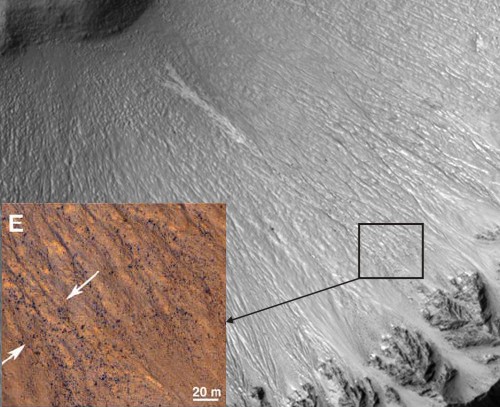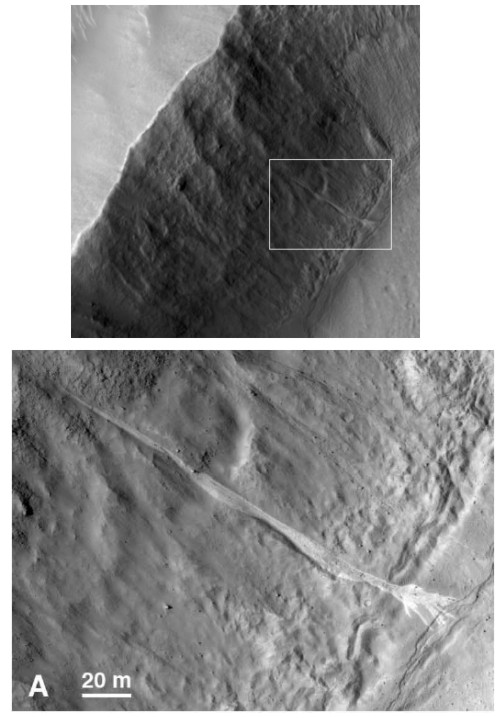Mars has a habit of disappointing us; exotic possibilities are presented to us, before fading away into nothingness when we look more closely. Percival Lowell’s canals didn’t survive close scrutiny, and now Phil reports that the merciless gaze of the HiRISE camera is casting doubt on the evidence seen in lower resolution imagery for recent flows of liquid water on the Martian surface.
If you recall, there was a lot of fuss at the end of last year about patches of bright material, which had appeared on some crater slopes imaged by the dear, departed Mars Global Surveyor where no such patches were seen in previous images. This evidence of recent activity on the Martian surface was made more exciting by the form that these bright patches took: they appeared to divert around elevated topography, and often fanned out at their ends. Could the bright material be mineral salts left behind as water escaping from the Martian subsurface evaporated or sublimed?
At the time, it was obvious that whilst all these observations were consistent with recent outbursts from a subterranean aquifer, we had no data which definitively established this – such as a spectrographic analysis of the bright patches. The first piece of bad tidings borne by last week’s Science paper by Alfred McEwan and his colleagues is that when you perform such analyses, IR spectroscopy reveals no signature of ice or hydrated minerals which might have been left by evaporating or subliming briny water. This is a blow, but more bad news comes when you take the closer visual look that HiRISE allows; in at least some cases, you can apparently trace the gulleys containing the bright material back up the crater slopes to what looks like areas of similar brightness, which the gulleys are cutting down into. Below is the best reported example of this (I went back to the original image to get the wide view, the colour close-up is from Figure 3 of the paper):

Both the spectroscopy and the improved imagery would therefore seem to give weight to the hypothesis that the bright patches are some sort of landslide, or dust flow, of material eroding from higher up the crater walls. I’m inclined to agree with this, because I’ve always struggled to reconcile the idea that water still regularly escapes from the subsurface with the fact that there seems to be quite a lot of shallowly buried ice/water left – how would it be replenished? In the interests of fairness, however, I don’t know if the case is entirely closed. Take a look at the HiRise imagery from one of the originally reported sites (wide view cropped from the original image, close-up from McEwan et al.’s supplementary information):

Although brighter material can be observed beyond the crater rim, I’m having trouble seeing any gullies on the upper crater wall which link it to the material below. In fact, the channel imaged here does seem to just spring from a point about a third of the way up the crater wall, which could conceivably be a little more consistent with some sort of outflow event. Perhaps the jury is still out.



Comments (1)